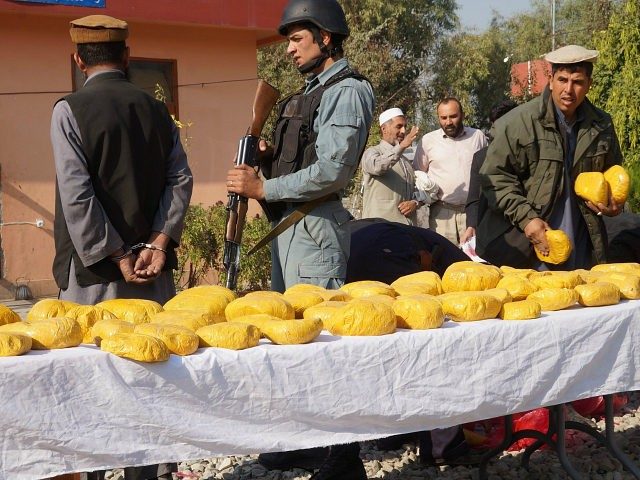The Trump administration’s record numbers of airstrikes in Afghanistan have failed to expand the Afghan government’s control over its population and stop the Taliban from quickly replacing its opium and heroin processing labs pulverized by the U.S. military, a watchdog agency said in a report to Congress released Tuesday.
In its latest quarterly audit to lawmakers, the U.S. Inspector General for Afghanistan Reconstruction (SIGAR) noted:
The expanded authorities provided [by President Trump] to U.S. forces in Afghanistan have resulted in a significant uptick in U.S. air strikes and special operations against the insurgency, with the U.S. dropping 653 munitions in October 2017, a record high since 2012 and a more than three-fold increase from October 2016.
These actions have yet to increase the Afghan government’s control over its population … The goal of the Afghan government is to control 80% of its population within the next two years.
While the U.S. military is targeting the Taliban’s opium business, dealing a blow worth millions of dollars to the group, it is barely making a dent on the illicit trafficking of the lucrative poppy plant, noted SIGAR, explaining:
U.S. and Afghan air strikes this quarter have targeted the Taliban’s opium-production industry, which the Drug Enforcement Administration (DEA) estimates has as many as 400–500 active facilities at any given time.
According to [U.S.] General [John] Nicholson, [the top commander of American and NATO forces in Afghanistan], U.S. and Afghan forces recently began targeting them, destroying 10 on November 19 alone.
Gen. Nicholson vowed to continue the pressure on the Taliban’s economic engine — opium and heroin — while remaining careful to avoid collateral damage and civilian casualties, which have increased by more than ten percent to 4,474 between June 1 and the end of November 2017 when compared to the same period the previous year.
Afghan security forces, supported by U.S. Air Force B-52s, F/A-18s, and other aircraft, including the F-22 Raptor, are carrying out the operations against opium and heroin, which generate up to 60 percent of the Taliban’s funding.
“Brigadier General Bunch announced that 25 narcotics labs had been destroyed since the beginning of the campaign in November, which he said was the equivalent of nearly $80 million eliminated from the drug-trafficking organizations while denying over $16 million in direct revenue to the Taliban,” reports SIGAR.
The inspector general suggested the cost of carrying out the airstrikes on the heroin labs may outweigh the outcome, noting:
According to the latest DOD [U.S. Department of Defense] financial- management report, an F-22 costs between $35,294 and $36,799 per hour to operate; a B-52 between $32,569 and $34,341 per hour; and an F/A-18 between $9,798 and $16,173 per hour, depending on the model.
By contrast, the labs being destroyed are cheap and easy to replace. Afghans told Reuters it would takes three or four days to replace a lab in Afghanistan. According to UNODC [United Nations Office on Drugs and Crime], the morphine/heroin labs need only simple equipment such as a stove, iron barrel, and locally made pressing machines. According to DOD, the value of seizures and destroyed equipment is based on DEA baselines.
In the report, SIGAR revealed that for the first time, the Pentagon prohibited the watchdog agency from publicizing the full district and land-area under the control of the Afghan government and terrorist groups.
The Pentagon also banned SIGAR from reporting on the strength and capabilities of the struggling Afghan National Defense and Security Forces (ANDSF), who, along with Afghan civilians, have borne the brunt of casualties primarily at the hands of the Taliban in recent years.
“Afghan government control or influence has declined and insurgent control or influence has increased overall since SIGAR began reporting control data in January 2016,” noted the auditor.
U.S. military combat deaths have also increased in recent months.
“From January 1 through November 26, 2017, 11 U.S. military personnel were killed in Afghanistan, and 99 were wounded. This is double the personnel killed in action compared to the same periods in 2015 and 2016,” noted SIGAR in a press release announcing its report to Congress.
Gen. Nicholson did say in November, “About 64 percent of the population is controlled by the government, about 24 percent live in contested areas, and the Taliban control the remaining 12 percent,” without mentioning anything about who controls the territory.
Based on the top commander’s assessment, Afghan terrorist groups, primarily the Taliban, control or contest 36 percent of the population.
Some independent analysts, namely experts from the Foundation for the Defense of Democracies (FDD), have questioned the U.S military’s assessment placing the territory under terrorist control or influence at about 45 percent in late September.
In a significant departure from previous administrations, President Trump authorized the U.S military to strike opium and its heroin derivative in Afghanistan, the world’s top producer of the poppy plant.
Despite investing $8.7 billion in American taxpayer funds on counternarcotics efforts since the Afghan war began in October 2001, Afghanistan is producing more opium and heroin than ever before, doubling production last year to 9,000 tons from 2016, revealed the United Nations.
The Islamic State (ISIS/ISIL) branch in Afghanistan is reportedly growing, claiming responsibility for an attack in Kabul this week and “the deadliest attack” covered by the SIGAR quarterly report “when an IS-K [Khorasan province] militant detonated a suicide bomb during a gathering of 150–200 people at a Shi’a cultural center in Kabul. The Afghan Ministry of Public Health said at least 41 people were killed and 84 wounded.”

COMMENTS
Please let us know if you're having issues with commenting.